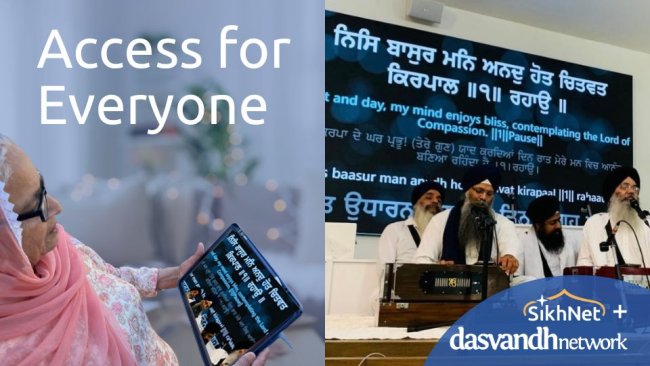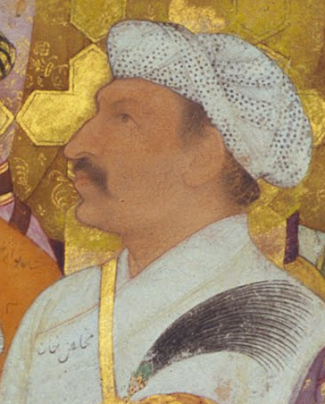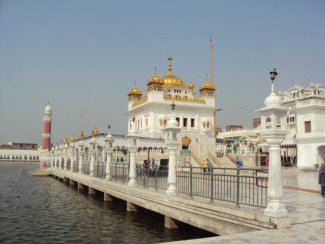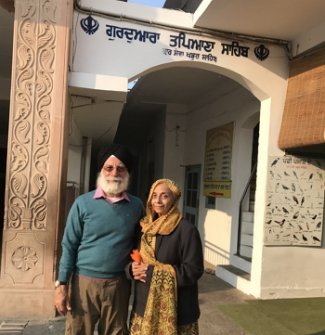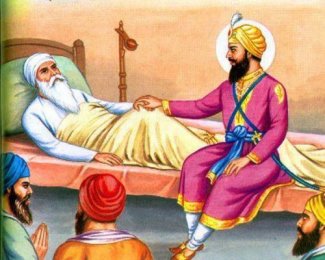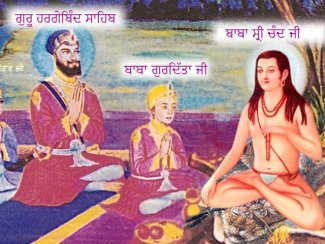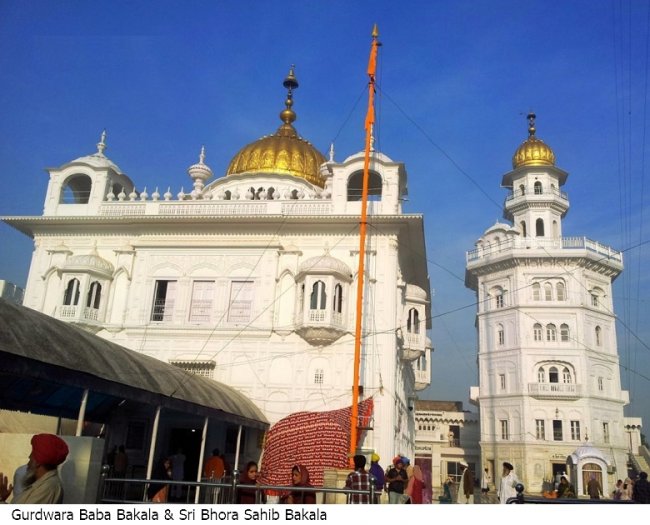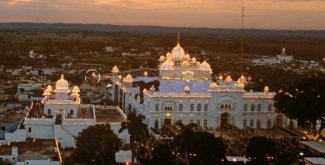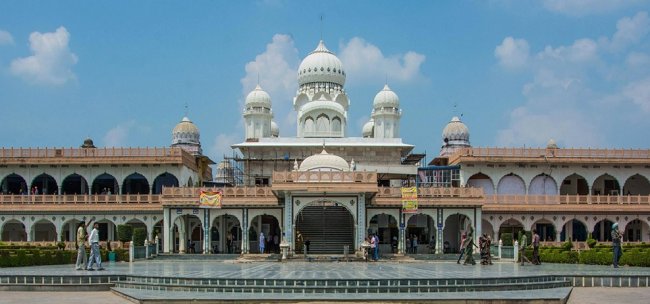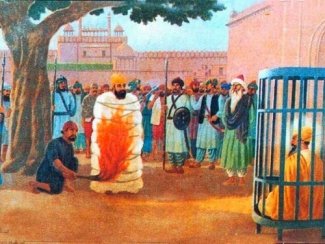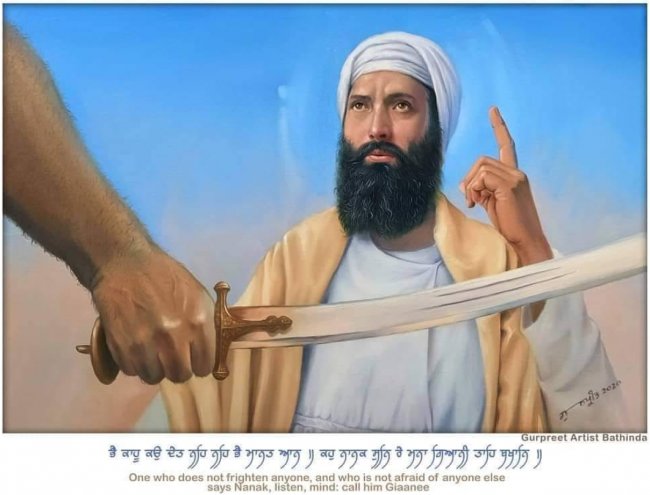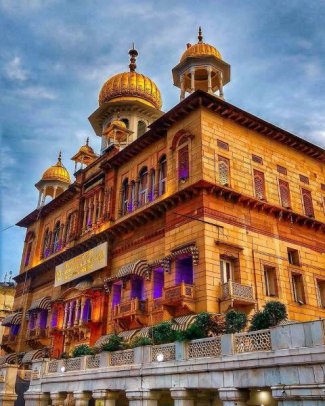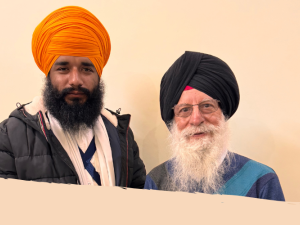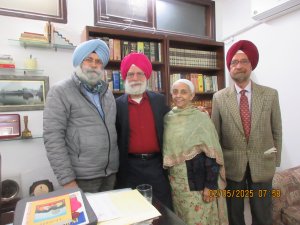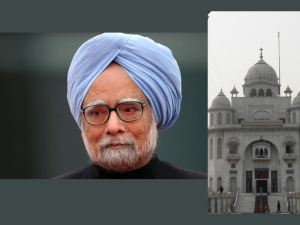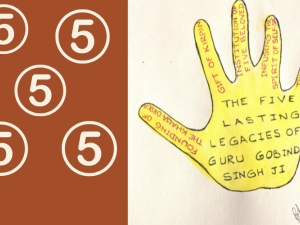The inevitable reality of human life is death. In fact, death and after-death remain unknown to us, while life is known as real and is being experienced, so naturally it is cherished by us. As a consequence, we all strive to live forever, be it by using the ambrosia or other easily available alternatives in the form of surgical interventions. We even try to shield children from exposure to the experience of death. We find it difficult to share the loss, its resulting void, including its reality honestly, as we are unsure of their mental capacity to process it and cope with it. But when early life has been shaped by multiple experiences of close encounters with this inevitable reality of life, it was bound to leave a lasting impression, by molding the thinking process as well as shaping the outlook to life. Guru Tegh Bahadur Ji’s life was filled with such experiences, yet he coped with them not just with tears alone but by becoming resilient.
Let us first explore this aspect of transitory nature of life from the writings in the Saloks and then try to connect to the life experiences that shaped them.
ਜਗ ਰਚਨਾ ਸਭ ਝੂਠ ਹੈ ਜਾiਨਿ ਲੇਹੁ ਰੇ ਮੀਤ ॥ ਕਹਿ ਨਾਨਕ ਥਿਰੁ ਨਾ ਰਹੈ ਜਿਉ ਬਾਲੂ ਕੀ ਭੀਤਿ ॥੪੯॥
ਰਾਮੁ ਗਇਓ ਰਾਵਨੁ ਗਇਓ ਜਾ ਕਉ ਬਹੁ ਪਰਵਾਰੁ ॥ ਕਹੁ ਨਾਨਕ ਥਿਰੁ ਕਛੁ ਨਹੀ ਸੁਪਨੇ ਜਿਉ ਸੰਸਾਰੁ ॥੫੦॥
ਚਿੰਤਾ ਤਾ ਕੀ ਕੀਜੀਐ ਜੋ ਅਨਹੋਨੀ ਹੋਇ ॥ ਇਹੁ ਮਾਰਗੁ ਸੰਸਾਰ ਕੋ ਨਾਨਕ ਥਿਰੁ ਨਹੀ ਕੋਇ ॥੫੧॥
ਜੋ ਉਪਜਿਓ ਸੋ ਬਿਨਸਿ ਹੈ ਪਰੋ ਆਜੁ ਕੈ ਕਾਲਿ ॥ ਨਾਨਕ ਹਰਿ ਗੁਨ ਗਾਇ ਲੇ ਛਾਡਿ ਸਗਲ ਜੰਜਾਲ ॥੫੨॥
ਜਗ ਰਚਨਾ ਸਭ ਝੂਠ ਹੈ ਜਾiਨਿ ਲੇਹੁ ਰੇ ਮੀਤ ॥ ਕਹਿ ਨਾਨਕ ਥਿਰੁ ਨਾ ਰਹੈ ਜਿਉ ਬਾਲੂ ਕੀ ਭੀਤਿ ॥੪੯॥
ਰਾਮੁ ਗਇਓ ਰਾਵਨੁ ਗਇਓ ਜਾ ਕਉ ਬਹੁ ਪਰਵਾਰੁ ॥ ਕਹੁ ਨਾਨਕ ਥਿਰੁ ਕਛੁ ਨਹੀ ਸੁਪਨੇ ਜਿਉ ਸੰਸਾਰੁ ॥੫੦॥
ਚਿੰਤਾ ਤਾ ਕੀ ਕੀਜੀਐ ਜੋ ਅਨਹੋਨੀ ਹੋਇ ॥ ਇਹੁ ਮਾਰਗੁ ਸੰਸਾਰ ਕੋ ਨਾਨਕ ਥਿਰੁ ਨਹੀ ਕੋਇ ॥੫੧॥
ਜੋ ਉਪਜਿਓ ਸੋ ਬਿਨਸਿ ਹੈ ਪਰੋ ਆਜੁ ਕੈ ਕਾਲਿ ॥ ਨਾਨਕ ਹਰਿ ਗੁਨ ਗਾਇ ਲੇ ਛਾਡਿ ਸਗਲ ਜੰਜਾਲ ॥੫੨॥
“Jug rachanaa sabh jhooTh hai jaan leho rae meet. Kaeh Nanak thir naa rahai jiau baaloo kee bheet. 49.
Raam gayo Raavan gayo jaa kau bahu paravaar. Kaho Nanak thir kachh nahee supane jiau sansaar . 50.
Chintaa taa kee keejeeaai joe anahonee hoi. Eih maarag sansaar ko Nanak thir nahee koye. 51.
Jo upajio so binas hai paro aaj kai kaal. Nanak har gun gaye ley chhaadd sagal janjaal. 52.”
(SGGS, Pg. No. 1429)
Translation: The whole world is transitory (therefore false); understand this well, my friend. Says Nanak, it is like a wall of sand (impermanent); which gets blown away as it shall not endure (the blow from the storm in the form of death). ||49|| (Even) Raam passed away, so did Raavan, despite his large family (that could not help stave it off). Says Nanak, nothing lasts forever; the world is like a passing dream. ||50|| Become anxious, only when something unexpected happens in reality. (But) this is the way of the world, O Nanak; nothing is lasting (here). ||51|| Whatever has been created shall perish; everything is perishable, (it is just a matter of time) today or tomorrow. O Nanak, sing the Glorious Praises of the Lord, leaving all other entanglements. ||52||
These words are borne out of real world experiences in life. Guru Ji has described this true reality of life succinctly; by sharing with us about the transitory nature of the world. Although, everyone in this world is cognizant of it, yet each acts as if it does not apply to him/her, as if carrying the exemption. The very act of trying to push the subject away on the false conviction of self’s invincibility does not alter the ground reality. However, during that time of mourning of a death of a close relative/associate, this notion of self’s invincibility evaporates by, only temporarily. At that time of grief, time is stretched out giving us a feeling of being drowned in an unending ocean. The feeling of loneliness is very strong, overpowering, giving rise to a feeling of helplessness. Imagine if this type of experience was replicated a few times, how emotionally devastating it can be, leaving us scarred for life, unless we have some sound grief support system. Let us explore Guru Tegh Bahadur’s life to understand how these experiences of grief molded him into a resilient being. How he learnt from it, and shared with us his observations for our benefit.
On 15 May 1628, the 7000 strong Mughals army under leadership of Mukhlis Khan attacked Amritsar. The Sikhs upon receiving the advance information on the impending attack evacuated Lohgarh, a small mud fort on the outskirts of the city, leaving only a small garrison to defend it. First day of the attack, Mughal army overran the fort, but the next day there was one to one combat between Guru Hargobind and Mukhlis Khan, where the later lost his life and as a consequence Mughal forces hastily retreated. Next day, Guru Ji’s daughter Bibi Veero’s wedding was solemnized at Jhabal as previously scheduled; simultaneously the dead in the battle were being cremated in Amritsar. Baba Tegh Bahadur’s eye-witnessed the sorrowful cremation of dead in the battle along with subdued celebration of his sister’s wedding. The irony of happiness and sorrow being integral parts of life were firmly imprinted in Baba's tender mind.
After the wedding the family returned back to Amritsar and in June 1628 Guru Hargobind, with his family, paid a visit to Tarn Taran. The visit was nostalgic for Baba Tegh Bahadur, as the city of Tarn Taran was established by his grandfather, Guru Arjan Dev Ji. There, Baba Tegh Bahadur learnt first hand about the supreme sacrifice of his grandfather from the eyewitnesses there, who were still alive. From there they visited Khadur Sahib and Goindwal, their ancestral home.
Here at both these places he was not just reappraised of the glorious history of Guru Angad Dev, and Guru Amar Das Ji but also inspired by it. Baba Tegh Bahadur's grandmother and Guru Arjan Dev Ji’s consort Mata Ganga passed away at Bakala, again leaving a void in Baba’s world.
Baba Tegh Bahadur, born in April 01, 1621 and was about 7-1/2 years old, when his older brother Baba Atal passed away on July 23, 1628. Baba Atal was about 9 years of age; he was a constant companion of Baba Tegh Bahadur at home and in the playgrounds. The void created by the loss of sibling bond on the younger surviving sibling can be traumatic. They were not just brothers, but real buddies and best friends. We can imagine the type of void that was left behind in young Baba Tegh Bahadur’s world. Baba Tegh Bahadur made music as one of the chief sources of his divine inspiration as well as for processing the grief of bereavement.
During the winter of 1631, Baba Buddha, Tegh Bahadur’s teacher, invited Guru Hargobind with his family to visit him, as his end was approaching. Guru Ji came to village Ramdas, 20 miles from Amritsar and Baba Tegh Bahadur accompanied him. Baba Tegh Bahadur was about 10 years old, as he witnessed with calm detachment and a suppressed sorrow the grand end of his teacher at 125 who had initiated him into the world of knowledge and wisdom. Baba Buddha had spent time with the first six Gurus and he used to share anecdotes, plus sayings of the Gurus with Tegh Bahadur. Through these discourses Baba Buddha had instilled the lessons of mysticism in Baba Tegh Bahadur. The void felt by Baba Tegh Bahadur cannot be described in words. It can be presumed that along with grief, Baba Tegh Bahadur continued his bond with his reverend teacher through cherished memory and found solace, comfort in that precious memory.
In April 1635, Guru Hargobind got a message informing him about the preparations of attack on him from Lahore. Babas Gurditta and Tegh Bahadur got permission from Guru Hargobind to join the battle of Kartarpur. Although Baba Tegh Bahadur was just 14 at that time, he displayed exemplary bravery in that battlefield. The Imperial army received a crushing defeat with several thousands dead, while the Sikhs lost 700 in the battle. So this time young tender hearted Baba Tegh Bahadur again witnessed gory deaths in a traumatic setting of the battlefield.
One day Guru Hargobind expressed his desire to visit Goindwal, as he had an intuition of Bhai Gurdas’s end approaching. Bhai Gurdas was elated on seeing Guru Ji visiting with him at the time of his departure. Bhai Sahib in a reminiscent mood, recollected the sweet memories of his beloved uncle Guru Amar Das, his brother-in-law Guru Ram Das, and happiest moments of his childhood and adult life spent with Guru Arjan Dev Ji. Guru Hargobind blessed Bhai Gurdas Ji, who breathed his last in Guru Ji’s arm on August 25, 1636. Baba Tegh Bahadur was there with Guru Ji witnessing this very emotional parting, and wondering that he was not going to hear the sweet voice of this sage and his teacher anymore. Bhai Gurdas’s life and teachings have had a deep influence on the tender mind of Baba Tegh Bahadur.
In 1638, Baba Gurditta, eldest brother of Baba Tegh Bahadur passed away, which was again a great shock for him. Same year, Bidhi Chand who was also Baba Tegh Bahadur’s teacher of arms training passed away. These events made him experience the impermanence of human life acutely. Two years later Babak, whose melodious voice had sung the hymns of Guru for two decades in Gurudwaras saw his end approaching. The great musician who had taught Baba Tegh Bahadur various musical instruments as well as intricacies of musical measures – ragas, was no more. This melodious voice had soothed Baba Tegh Bahadur’s soul during such trying times earlier, was not to be heard anymore. This was followed by the demise of Jati Mal, who had taught Baba all the skills of warfare.
Never in his life did Baba Tegh Bahadur feel that acutely impermanence of fleeting mortal life, as he felt at that time. He had seen deaths of his brothers and teachers in such a quick succession that death had made a lasting impression on his psyche. These lingering impressions left deep imprints, and every time one thinks about these events there is a moment of loneliness, which is quite strong, yet it acts as a reminder of the inevitable reality that catches up with everyone. These deaths, losses, and separation cast a lasting influence on Baba Ji the way life was to be seen, experienced as well as how to cope with deaths. Through these tragic losses, Baba became resilient in life.
Guru Hargobind spent the last ten years of his life in Kiratpur, breathing his last there on March 04, 1644. For Tegh Bahadur this period was of uninterrupted bliss in the company of his father. Baba Tegh Bahadur was an eyewitness to another death of a very close family member, the biological cum spiritual father. According to M. Latif’s History of Panjab, “his death was considered a national calamity.” Baba Tegh Bahadur was just 23 at that time and after a month of the last rites, Baba Tegh Bahadur moved to Bakala as per his father’s instructions and spent considerable time in meditation. During this period he undertook a preaching tour of the east at the direction of seventh Guru Har Rai in 1656. Unfortunately, he had to cut short his tour and return back upon hearing the news of the passing away of Guru Har Rai in 1661. During his return in Delhi he had visited Guru Har Krishan Ji, the successor eight Guru on 21 March 1664, before returning back to Bakala.
Baba Tegh Bahadur was anointed as ninth Guru by Guru Har Krishan Ji, before he breathed his last on March 30, 1664. After assuming the responsibilities in 1665 he undertook a tour of Panjab and founded the city now known as Anandpur Sahib. Then he resumed the tour of the east from 1666 to 1670. Guru Tegh Bahadur returned back to Anandpur in February 1672. He spent the next two years preaching in areas of Punjab.
In May 1675, a strong delegation of 500 Kashmiri Pundits led by Pundit Kirpa Ram visited Anandpur, pleaded for help with the forced conversions that they were being subjected to. After serious deliberations, Guru Ji told Pundits seeking succor that they should convey to the Governor and the Emperor to stop individual coercion, but if he could convert Guru Tegh Bahadur to Islam they all would follow suit. Suddenly, this gauntlet was a game changer, it coalesced the direction of the conversion drive. As soon as the message reached Emperor Aurangzeb, his next step was to issue summons for the arrest of Guru Tegh Bahadur. Guru Ji was arrested in Sikandra, near Agra and brought to Delhi.
When inducements failed to achieve the objective of conversion, Guru Ji was asked to show Karamat (miracle). Which was again refused by Guru Ji, then torture regimen was unleashed on him, followed by torture execution of his three subordinates to weaken his resolve. Upon failing on their objective of conversion, Guru Ji was executed on November 11, 1675.
The final fate that Guru Ji was subjected to was sealed by the very offer that Guru Ji had made for the protection of Kashmiri Pundits. It takes a tremendous spiritual fortitude to offer self’s life for others. He gave his life with a smile on his face and prayers on his lips. Such an offer goes against the very normal human appetite for a longer life. This decision has to be viewed through Guru Ji’s own life as lived, in the close encounters with inevitable reality of death from early childhood. Here we find a complete absence of the normal human appetite for a long life. This unique perspective was borne out of crystal clear thoughts on objective and purpose of life, coupled with knowledge of the redundancy of life without that moral compass. It is this supreme sacrifice that earned Guru Ji the honorific of “Hind de Chaddar” meaning protective shield over India.
The psychological suffering that Guru Ji endured, through eye witnessing the torture and killing his close subordinates before his own sacrifice was mind numbing. The sacrifice of his grandfather Guru Arjan Dev Ji, set a benchmark that the grandson upheld by laying down his own life for the rights to freely practice one’s faith. He sacrificed to uphold those articles of faith as sacred, the thread around the body and forehead marks, which have not been a part of the faith initiated by Guru Nanak Ji, has no parallels in world history. Besides the Salokas above, his other bani counters the popular human misconception based on desire to live forever, underscoring the relationship of death to life. Let us explore a few snippets from his writings.
ਸਾਧੋ ਰਚਨਾ ਰਾਮ ਬਨਾਈ ॥ ਇਕਿ ਬਿਨਸੈ ਇਕ ਅਸਥਿਰੁ ਮਾਨੈ ਅਚਰਜੁ ਲਖਿਓ ਨ ਜਾਈ ॥੧॥ ਰਹਾਉ ॥
“Saadho rachanaa raam banaiee. Eik binasai ik asathir maanai acharaj lakhio na jaiee. 1. Rahaau.” (SGGS, Pg. No. 219)
Translation: Holy Saadhus: the Lord has created such a play of the universe, that one person passes away, and another thinks that he will live forever - this is a wonder beyond understanding! 1. Pause.
ਰੇ ਨਰ ਇਹ ਸਾਚੀ ਜੀਅ ਧਾਰਿ ॥ ਸਗਲ ਜਗਤੁ ਹੈ ਜੈਸੇ ਸੁਪਨਾ ਬਿਨਸਤ ਲਗਤ ਨ ਬਾਰ ॥੧॥ ਰਹਾਉ ॥
“Rae nar eh saachee jeea dhaar. Sagal jagat hai jaise supanaa binasat lagat na baar. 1. Rahaau.” (SGGS, Pg. No. 633)
Translation: O man, grasp this Truth firmly in your mind. The whole world is just like a dream; it will be gone in an instant. 1. Pause.
ਜਾਗ ਲੇਹੁ ਰੇ ਮਨਾ ਜਾਗ ਲੇਹੁ ਕਹਾ ਗਾਫਲ ਸੋਇਆ ॥ ਜੋ ਤਨੁ ਉਪਜਿਆ ਸੰਗ ਹੀ ਸੋ ਭੀ ਸੰਗਿ ਨ ਹੋਇਆ ॥੧॥ ਰਹਾਉ ॥
“Jaag leho re munaa jaag leho kahaa gaafal soiaa. Joe tan upajiaa sang hee so bhee sang na hoiaa. 1. Rahaau.” (SGGS, Pg. No. 726)
Translation: Wake up, O mind! Wake up! Why are you sleeping unaware? Even the body, which you were born with, shall not go along with you in the end. 1. Pause.
ਕਹਾ ਮਨ ਬਿਖਿਆ ਸਿਉ ਲਪਟਾਹੀ ॥ ਯਾ ਜਗ ਮਹਿ ਕੋਊ ਰਹਨੁ ਨ ਪਾਵੈ ਇਕਿ ਆਵਹਿ ਇਕਿ ਜਾਹੀ ॥੧॥ ਰਹਾਉ ॥
“Kahaa mun bikhiaa siau lapaTaahee. Yaa jag meh kouoo rahan na paavai ik aaveh ik jaahee. 1. Rahaau.” (SGGS, Pg. No. 1231)
Translation: O my mind, why are you clinging to sensual pleasures? No one is allowed to remain in this world forever; one comes, and another departs. 1. Pause.
From these quotes above we can see that Guru Ji has talked about the transitory nature of life, with an expiry date and time. We all die, when our turn comes, yet life goes on as usual. This was the knowledge that prepared him uniquely to lay down his own life. Guru lived his life feeling the divine presence within, so he had no fear of death, as death was not going to take that away. This divine knowledge provided the requisite strength with firm conviction to renounce the love of life. Guru Ji offered his own life to uphold the right of freedom to practice one’s chosen faith. This was during the period, when these freedoms were only for those who professed the faith of the ruler. The price for professing anything not officially sanctioned was becoming second class citizens or even death.
Guru Ji through his sacrifice has shared that the life given at the altar for a higher purpose can spawn a new revolution. When the purpose is greater than our own selves, it is empowering for the rest. Such a life giving is held in awe by the masses and it can change the course of history. The art of dying is the art of living. The desolate wailing of the tomb of the perpetrator in Aurangabad tells the story that history books don’t. While the site of execution has become the pilgrim’s shrine defying the seat of power Red Fort forever.
References:
-
Singh, Ranbir. Guru Tegh Bahadur; Divine Poet, Savior and Martyr. Chief Khalsa Diwan. 1975.
-
Singh, Dr. Trilochan. Guru Tegh Bahadur: Prophet and Martyr. Gurdwara Parbandhak Committee, Delhi. 1967.
-
Kohli, Dr. Surindar Singh. The Sword and the Spirit. National Book Shop. Delhi
-
Dil, Dr. Balbir Singh. Guru Tegh Bahadur: Jeewan Te Rachna (Punjabi). Punjabi University. 1975.
-
Singh, Fauja & Talib, Gurbachan Singh. Guru Tegh Bahadur: Martyr and Teacher. Punjabi University. 1996.
-
Kohli, Mohinder Pal. Guru Tegh Bahadur: Testimony of Conscience. Sahitya Akademi (1992)
-
Talib, G. S. (Ed.) Guru Tegh Bahadur: Background and Supreme Sacrifice. Punjabi University, Patiala (1999)
